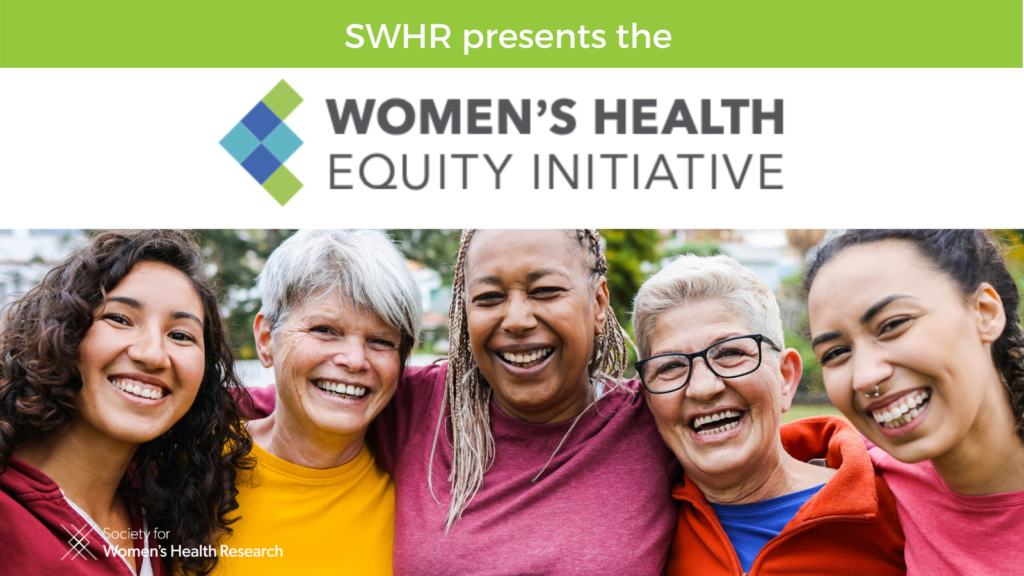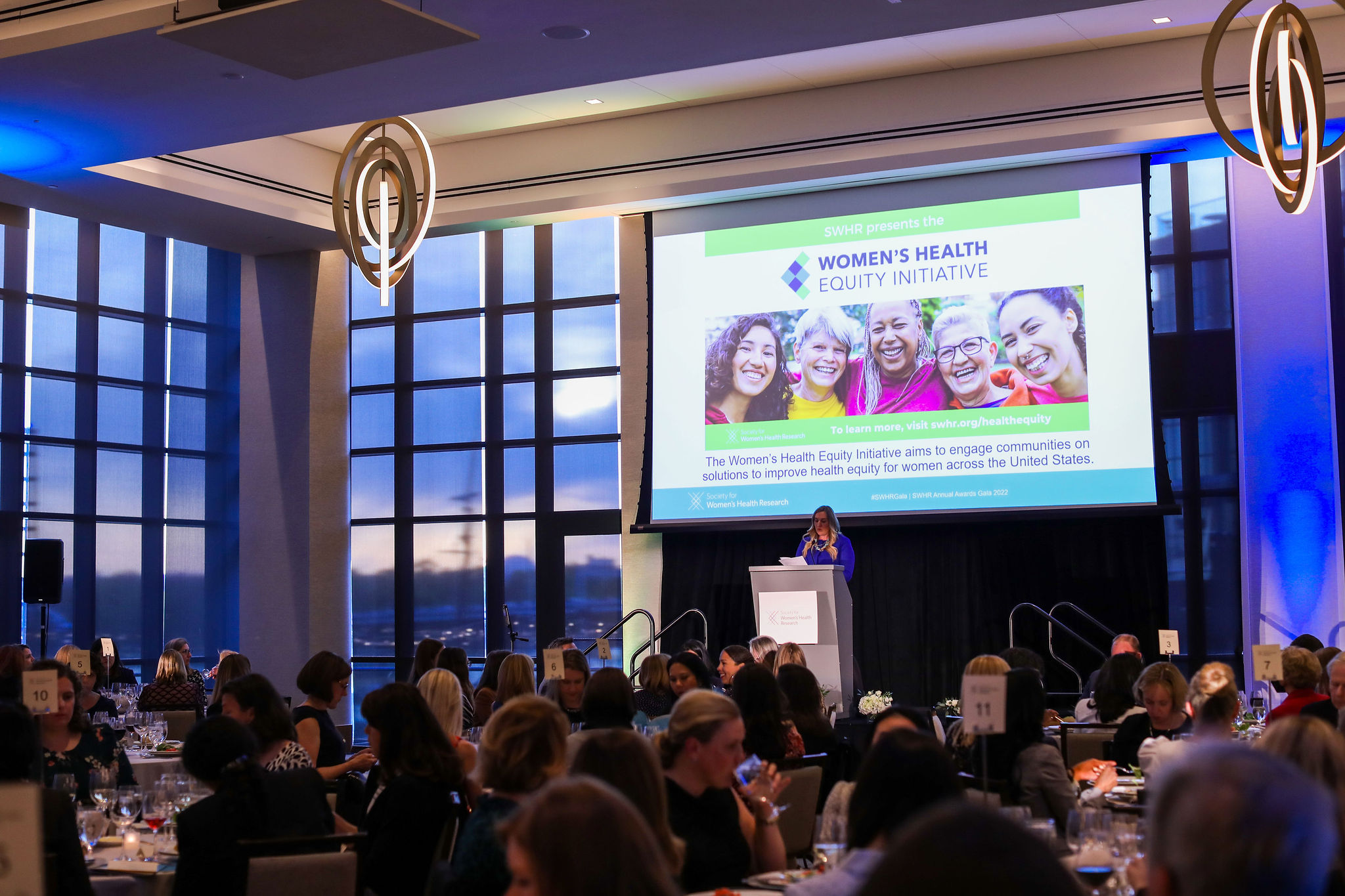Illuminating Disparities and Addressing Outcomes with the Women’s Health Equity Initiative

Women in the United States experience health disparities throughout their lifespans as a result of their gender, historic health inequities in the health care system, and socioeconomic conditions. Sixteen percent of women report fair or poor health status, according to the Centers for Disease Control and Prevention (CDC)’s Behavioral Risk Factor Surveillance System (BRFSS), and these percentages are even higher among women of color, including 23% of Native American women, 22% of Hispanic women, and 20% of Black women.
In an effort to identify and address these disparities and gaps in care, the Society for Women’s Health Research (SWHR) launched the Women’s Health Equity Initiative to highlight statistics on women’s health in the United States and engage communities on solutions to improve health equity across multiple disease states, conditions, and life stages — focusing on Alzheimer’s disease, bone health, maternal health, and menopause to begin.
As a starting point, these four areas represent an important cross section of women’s health disparities in the United States—across the lifespan, across geographies, and for both patients and caregivers. In exploring each condition further, SWHR hopes to elevate conversations about the health disparities women face and build solutions across science and care, education, awareness, and policy.
Addressing Disparities in Alzheimer’s Disease
Alzheimer’s disease and related dementias (AD/ADRD) disproportionately affect women and minority populations, with women of color facing a particularly high burden. The estimated total health care costs for the treatment of Alzheimer’s disease in 2020 is $305 billion, and it is expected to increase to more than $1 trillion in coming years. Informal and unpaid AD/ADRD caregivers, who are 63% women, provide approximately 18.6 billion hours of unpaid care at year, costing an estimated $244 billion. Given the aging population, efforts to address AD/ADRD burdens and gaps in care for women, who may be facing the disease themselves or acting as an AD caregiver, must be accelerated, by bringing attention to clinical, education, and policy needs. Learn more about disparities women face in AD/ADRD in the Alzheimer’s portion of the Health Equity Roadmap.
Improving Women’s Outcomes for Bone Health
Osteoporosis is often called the “silent disease” because patients typically show no symptoms until a bone is broken or fractured. This can lead to a delay in diagnosis, prevention, and proper treatment. Osteoporosis disproportionately affects women, with a diagnosis rate of 1 in 5 in women aged 50 and older, compared to just 1 in 20 in men over 50. The burden of living with osteoporosis increases for Medicare and minority populations. Black Medicare beneficiaries have higher hospitalization rates, higher death rates following fractures, and lower bone mineral density screening rates. Experts estimate costs of providing care for osteoporotic fractures among Medicare beneficiaries will rise from $57 billion to $95 billion by 2040. Offering screenings and promoting prevention efforts are important steps to help decrease the effects of osteoporosis. Learn more about disparities women face when caring for their bone health in the bone health portion of the Health Equity Roadmap.
Moving Maternal Health Forward
The United States has the highest rate of maternal death among developed nations. About 700 women die each year as a result of pregnancy or delivery complications. The U.S. maternal death rate differs between states and has significant racial disparities. Rural areas lack access to high quality maternal health services due to hospital and obstetric department closures and face workforce shortages. Black and Native American women face higher rates of pregnancy-related deaths compared to non-Hispanic white women, and Black and Hispanic women are at significantly higher risk for severe maternal morbidity, such as preeclampsia. Recent evidence suggests that the stress associated with situational experiences of racial discrimination among Black women can increase the risk of negative perinatal outcomes. Without addressing gaps in access and racial disparities in maternal health care, we will not fully tackle women’s health inequities. Learn more about maternal health disparities in the maternity portion of the Health Equity Roadmap.
Transforming the Menopause Transition
While the menopausal transition most often begins in women between ages 45 and 55, transition timing and duration can depend greatly on health history, lifestyle factors, socioeconomic status, and race and ethnicity. Black, Asian American, and Hispanic women on average begin menopause earlier than non-Hispanic white women. Those who experience menopause early also often experience certain physiological effects of menopause earlier in life, such as bone density decline, increase in fat mass, decrease in muscle, and increase in cholesterol, many of which can increase the likelihood of later-life health consequences. The limited resources allocated to the menopause transition directly affects women’s well-being, and health spending. Globally, menopause-related productivity losses can amount to more than $150 billion a year, on top of the cost to the health care system and each individual patient. Addressing disparities in menopause care requires both policy and clinical progress. Learn more about disparities many women face during their menopause transition in the menopause portion of the Health Equity Roadmap.
The Future of Health Disparities Work
The work of addressing health disparities and closing gaps in care outcomes requires the participation of stakeholders across the health care ecosystem. SWHR plans to address additional disease states, life stages, and issues through this initiative in the future. SWHR is proud to build on its efforts to end women’s health disparities through this initiative, and looks forward to continuing work with our partners to make women’s health mainstream.
Learn more about the Women’s Health Equity Initiative at swhr.org/healthequity.
Women in the United States experience health disparities throughout their lifespans as a result of their gender, historic health inequities in the health care system, and socioeconomic conditions. Sixteen percent of women report fair or poor health status, according to the Centers for Disease Control and Prevention (CDC)’s Behavioral Risk Factor Surveillance System (BRFSS), and these percentages are even higher among women of color, including 23% of Native American women, 22% of Hispanic women, and 20% of Black women.
In an effort to identify and address these disparities and gaps in care, the Society for Women’s Health Research (SWHR) launched the Women’s Health Equity Initiative to highlight statistics on women’s health in the United States and engage communities on solutions to improve health equity across multiple disease states, conditions, and life stages — focusing on Alzheimer’s disease, bone health, maternal health, and menopause to begin.
As a starting point, these four areas represent an important cross section of women’s health disparities in the United States—across the lifespan, across geographies, and for both patients and caregivers. In exploring each condition further, SWHR hopes to elevate conversations about the health disparities women face and build solutions across science and care, education, awareness, and policy.
Addressing Disparities in Alzheimer’s Disease
Alzheimer’s disease and related dementias (AD/ADRD) disproportionately affect women and minority populations, with women of color facing a particularly high burden. The estimated total health care costs for the treatment of Alzheimer’s disease in 2020 is $305 billion, and it is expected to increase to more than $1 trillion in coming years. Informal and unpaid AD/ADRD caregivers, who are 63% women, provide approximately 18.6 billion hours of unpaid care at year, costing an estimated $244 billion. Given the aging population, efforts to address AD/ADRD burdens and gaps in care for women, who may be facing the disease themselves or acting as an AD caregiver, must be accelerated, by bringing attention to clinical, education, and policy needs. Learn more about disparities women face in AD/ADRD in the Alzheimer’s portion of the Health Equity Roadmap.
Improving Women’s Outcomes for Bone Health
Osteoporosis is often called the “silent disease” because patients typically show no symptoms until a bone is broken or fractured. This can lead to a delay in diagnosis, prevention, and proper treatment. Osteoporosis disproportionately affects women, with a diagnosis rate of 1 in 5 in women aged 50 and older, compared to just 1 in 20 in men over 50. The burden of living with osteoporosis increases for Medicare and minority populations. Black Medicare beneficiaries have higher hospitalization rates, higher death rates following fractures, and lower bone mineral density screening rates. Experts estimate costs of providing care for osteoporotic fractures among Medicare beneficiaries will rise from $57 billion to $95 billion by 2040. Offering screenings and promoting prevention efforts are important steps to help decrease the effects of osteoporosis. Learn more about disparities women face when caring for their bone health in the bone health portion of the Health Equity Roadmap.
Moving Maternal Health Forward
The United States has the highest rate of maternal death among developed nations. About 700 women die each year as a result of pregnancy or delivery complications. The U.S. maternal death rate differs between states and has significant racial disparities. Rural areas lack access to high quality maternal health services due to hospital and obstetric department closures and face workforce shortages. Black and Native American women face higher rates of pregnancy-related deaths compared to non-Hispanic white women, and Black and Hispanic women are at significantly higher risk for severe maternal morbidity, such as preeclampsia. Recent evidence suggests that the stress associated with situational experiences of racial discrimination among Black women can increase the risk of negative perinatal outcomes. Without addressing gaps in access and racial disparities in maternal health care, we will not fully tackle women’s health inequities. Learn more about maternal health disparities in the maternity portion of the Health Equity Roadmap.
Transforming the Menopause Transition
While the menopausal transition most often begins in women between ages 45 and 55, transition timing and duration can depend greatly on health history, lifestyle factors, socioeconomic status, and race and ethnicity. Black, Asian American, and Hispanic women on average begin menopause earlier than non-Hispanic white women. Those who experience menopause early also often experience certain physiological effects of menopause earlier in life, such as bone density decline, increase in fat mass, decrease in muscle, and increase in cholesterol, many of which can increase the likelihood of later-life health consequences. The limited resources allocated to the menopause transition directly affects women’s well-being, and health spending. Globally, menopause-related productivity losses can amount to more than $150 billion a year, on top of the cost to the health care system and each individual patient. Addressing disparities in menopause care requires both policy and clinical progress. Learn more about disparities many women face during their menopause transition in the menopause portion of the Health Equity Roadmap.
The Future of Health Disparities Work
The work of addressing health disparities and closing gaps in care outcomes requires the participation of stakeholders across the health care ecosystem. SWHR plans to address additional disease states, life stages, and issues through this initiative in the future. SWHR is proud to build on its efforts to end women’s health disparities through this initiative, and looks forward to continuing work with our partners to make women’s health mainstream.
Learn more about the Women’s Health Equity Initiative at swhr.org/healthequity.
